Ancient Rome is often remembered for its thrilling gladiatorial combats and high-speed chariot races that captivated large audiences. These spectacles were undoubtedly central to Roman entertainment, drawing crowds to grand arenas. Yet, beyond these well-known events, Romans enjoyed a rich variety of leisure activities that engaged people across social classes.
Ancient Roman board games represent a significant facet of Roman entertainment. These games were more than simple pastimes; they offered strategic challenges and opportunities for social interaction. Found in public spaces and private homes alike, board games held an important place in daily Roman life.
In this article, you will discover some of the most popular Ancient Roman board games, including their gameplay mechanics and the role they played in building connections among players. This exploration sheds light on how Roman leisure activities extended well beyond the arenas, highlighting a vibrant culture of gaming and socializing.
The Role of Board Games in Ancient Roman Society
Board games in Roman society transcended social boundaries, enjoyed by everyone from emperors to common citizens. These games were not reserved for a specific class; instead, they provided a shared space for entertainment and intellectual challenge across the spectrum of Roman life.
Public Spaces for Gaming
Public gaming spaces such as amphitheaters and forums often featured dedicated areas where spectators could watch intense matches or join in the play themselves. These venues became social hubs where strategy and skill were admired, attracting large crowds eager to witness contests of wit rather than physical strength alone.
Private Bonding Through Play
In private settings, board games acted as catalysts for bonding among family members and friends. Playing together during gatherings created opportunities for conversation, laughter, and competition in an informal atmosphere. These intimate moments of leisure balanced the grandeur of public spectacles with more personal enjoyment.
Key aspects of board gaming in Ancient Rome:
- Inclusive participation across all social classes
- Public arenas designed for both viewing and playing
- Private entertainment fostering connections within households
Roman board games offered more than just pastime activities; they shaped social interactions by bringing people together in both communal and familial contexts.
Terni Lapilli and Tria: Early Strategy Games
Terni Lapilli stands out as one of the simplest yet most engaging Roman strategy games. Often described as a Tic-Tac-Toe variant, it involved placing three pieces in a row to win. The game required foresight and tactical thinking, despite its straightforward rules. Players usually marked boards directly onto stone surfaces in public spaces, including amphitheaters and public monuments, inviting onlookers to join or watch.
An evolution of this concept was Tria, which increased complexity by expanding the number of pieces from three to nine per player. This allowed for deeper strategic plays and prolonged matches, appealing to those who favored more intricate challenges.
Both Terni Lapilli and Tria exemplify how early Roman board games combined accessibility with strategic depth. Their presence in prominent public locations highlights their popularity and social importance beyond casual pastime. These games laid a foundation for more complex Roman gaming traditions that followed.
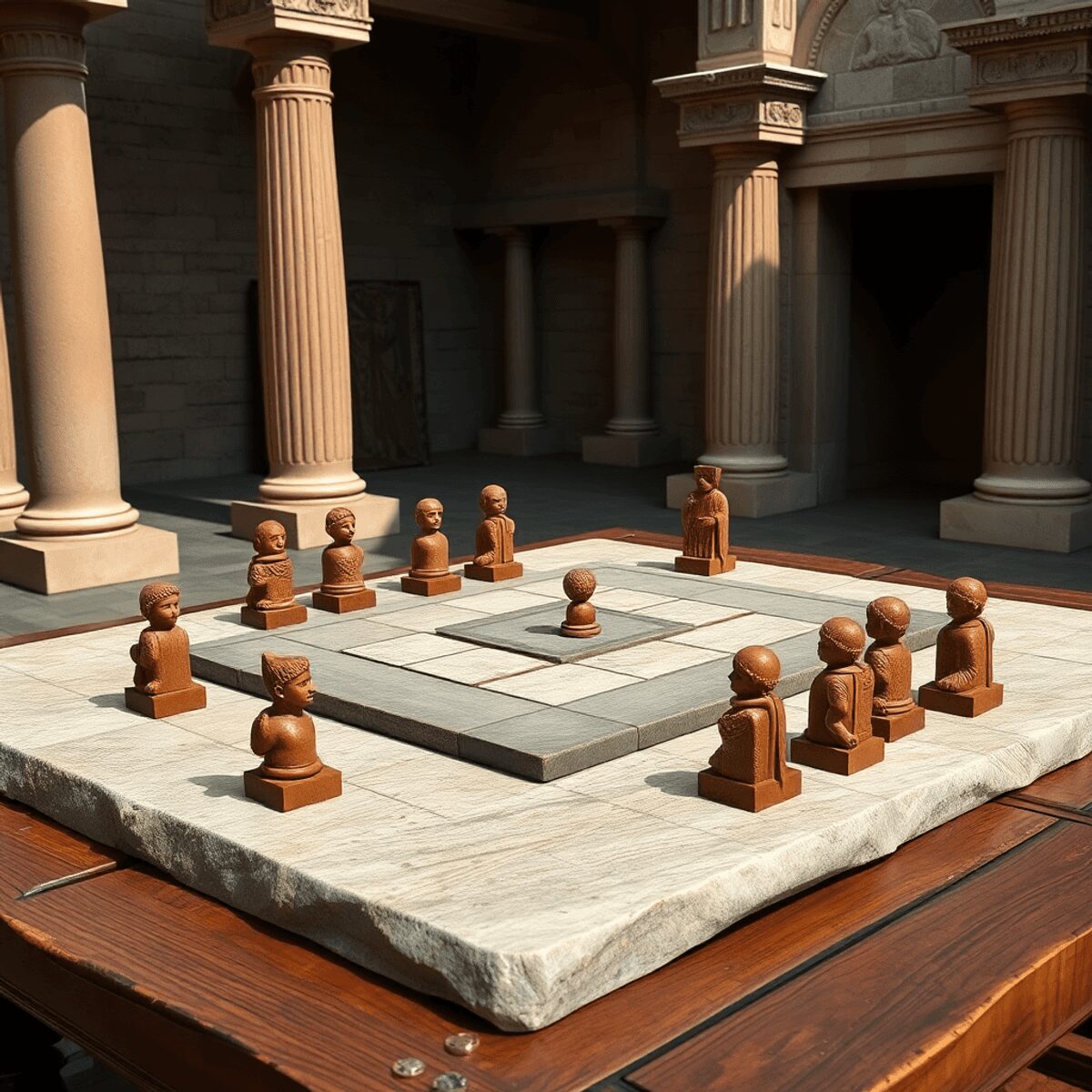
Ludus Latrunculorum: The Precursor to Chess
Ludus Latrunculorum stands out among Ancient Roman board games for its strategic gameplay simulating military battles. Players controlled armies composed of pieces representing soldiers, maneuvering them across a grid-like board to capture enemy units. This tactical aspect made it deeply engaging for Romans fascinated by warfare and strategy.
Key Features of Ludus Latrunculorum
- Often described as an ancient chess precursor, Ludus Latrunculorum required foresight, planning, and the ability to anticipate opponents’ moves.
- The game’s complexity exceeded simpler pastimes like Terni Lapilli, appealing to those who enjoyed intellectual challenges tied to military tactics.
- Pieces moved in straight lines across the board, with capturing achieved by surrounding opposing units—a mechanic echoing elements seen in later strategic games.
Ludus Latrunculorum’s design reflects Rome’s martial culture and highlights how board games were more than mere amusement; they were exercises in strategic thinking that mirrored real-life conflict scenarios. This link between play and strategy laid foundational concepts that influenced the evolution of modern chess.
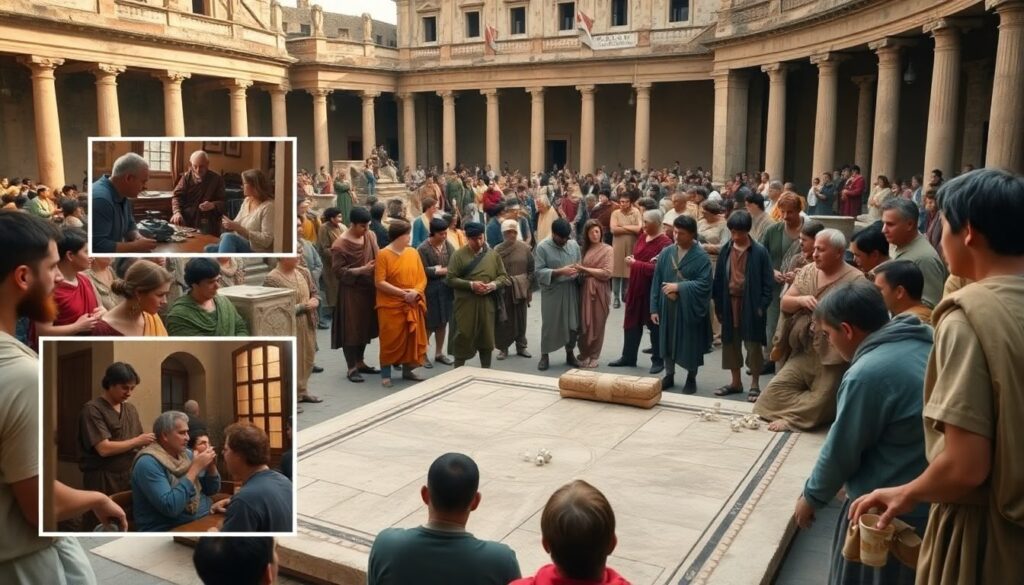
Duodecim Scripta and Tabula: Ancestors of Backgammon
Duodecim Scripta was a popular Roman race and strategy game combining dice rolls with tactical piece movement along marked paths. Players competed to advance their pieces across a board divided into three rows of twelve squares, aiming to be the first to move all their pieces off the board. The game involved both luck, from rolling dice, and strategic decision-making about which pieces to move and when.
Tabula evolved from Duodecim Scripta, introducing a faster pace and more dynamic gameplay. It incorporated additional elements of chance and risk, making it more thrilling for players who enjoyed unpredictability alongside skill. Tabula’s rules resembled those of modern backgammon, where players race to remove their pieces from the board while blocking or capturing opponents’ pieces.
Both games are recognized as key predecessors to today’s backgammon. Their blend of chance and strategy demonstrated Romans’ appreciation for engaging, competitive entertainment that tested both luck and tactical thinking.
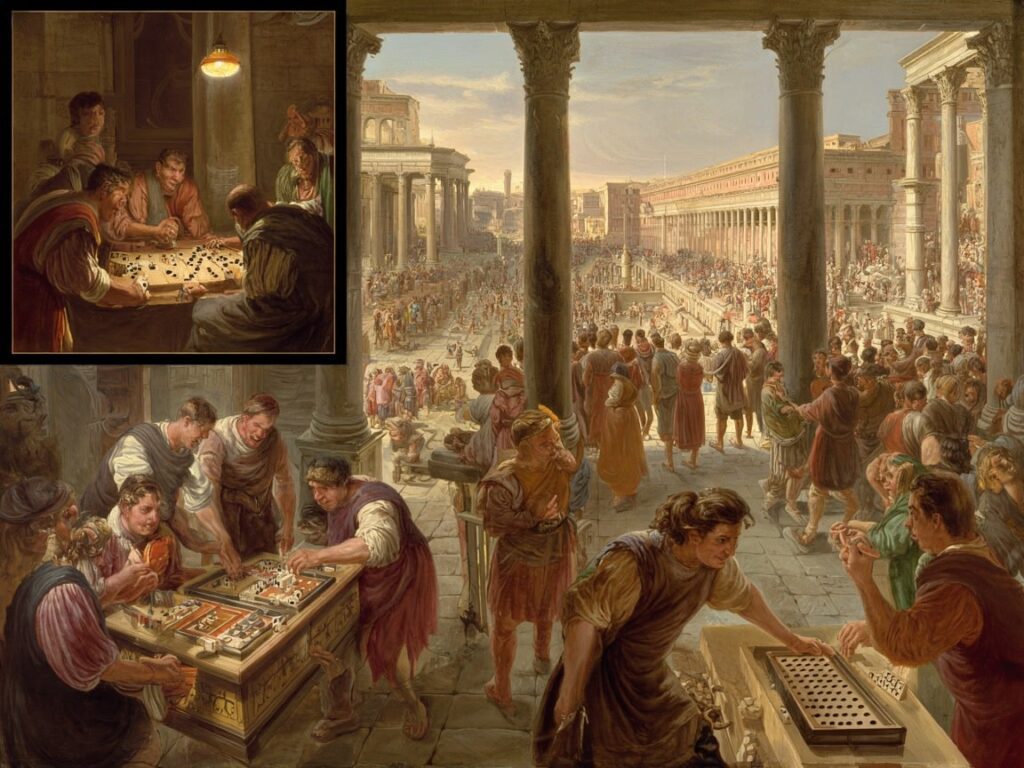
Dice Games and Gambling Culture in Rome
Dice games were a big part of how Romans spent their free time, with Tali—also known as knucklebones—being one of the most popular games. Unlike regular six-sided dice, Roman dice were often asymmetrical, meaning they had different shapes and numbers of sides to make the game less predictable. This variety allowed for different ways to gamble, attracting both casual players and serious bettors.
Skill and Strategy in Roman Dice Games
Roman dice games weren’t just based on luck; they also required skillful betting strategies and social interaction. Players would bet on the outcomes using coins or other valuable items, making these games an essential part of the gambling culture. Even though there were laws trying to limit excessive gambling, it was still widespread among all social classes.
The Importance of Fair Play
With high stakes involved, fair play became a concern. To prevent cheating, the fritillus, or dice tower, was invented as a practical solution. Players would drop the dice into the tower, ensuring that each roll was random by forcing the dice to tumble through an enclosed chute before landing on the playing surface.
Gambling Hotspots: Popinae and Wine Bars
Gambling establishments thrived during this time, often found in popinae—Roman wine bars—where customers could enjoy drinks while playing games. The popularity of tali and other dice games played a significant role in shaping Roman entertainment, combining elements of chance, skill, and risk in social settings that brought people together regardless of their social status.
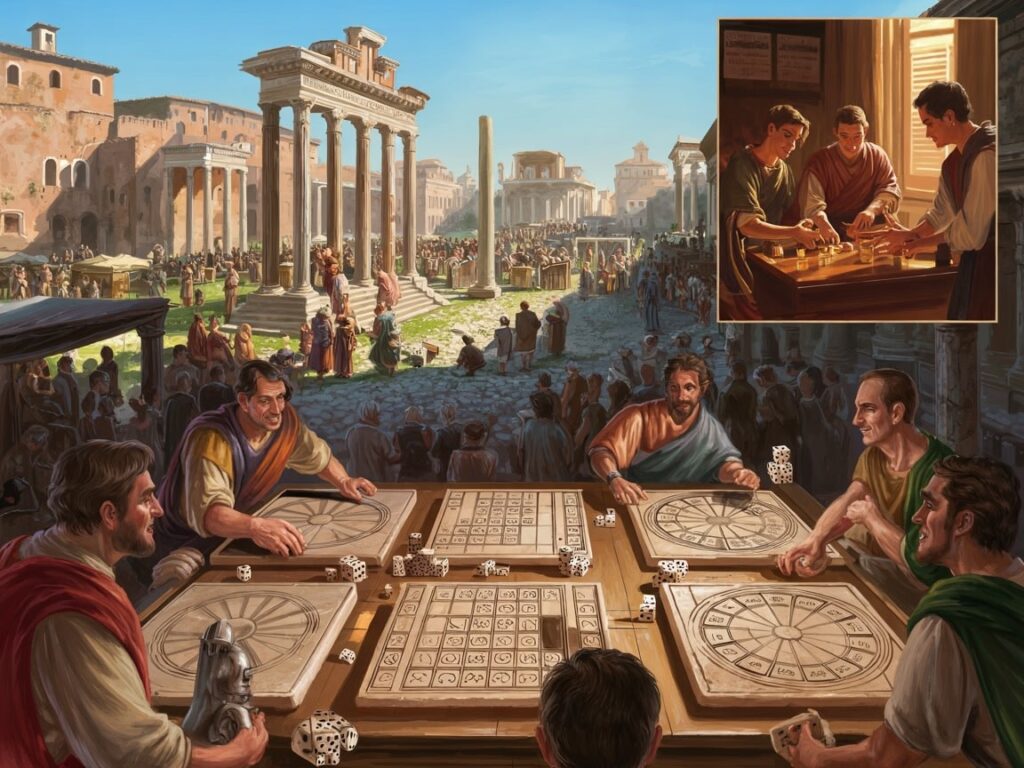
Social Context and Demographics of Roman Gaming Culture
Ancient Roman board games were embraced by people of all ages and social standings, reflecting a culture where gaming was both a pastime and a social glue.
- Roman children’s games: often included miniature battle simulations or toys mimicking government roles, helping youngsters engage with the societal structures around them in a playful manner. These activities served as early introductions to strategy and competition.
- Family leisure activities: Board games created spaces for bringing together relatives in homes for relaxed yet mentally stimulating entertainment. This private setting fostered bonds and allowed different generations to share time meaningfully.
- Communal gaming: Public venues also featured where citizens from various classes could interact. Game boards carved into stone surfaces in amphitheaters or marketplaces became meeting points, blurring social boundaries through shared participation.
- Common cultural experiences: The accessibility of games like Terni Lapilli or Duodecim Scripta made them You could find an emperor strategizing over Ludus Latrunculorum just as easily as a merchant enjoying a quick round with friends.
These facets of social interaction through gaming reveal how Ancient Roman board games extended far beyond mere entertainment. They functioned as vital tools for communication, education, and community engagement across Rome’s diverse population.
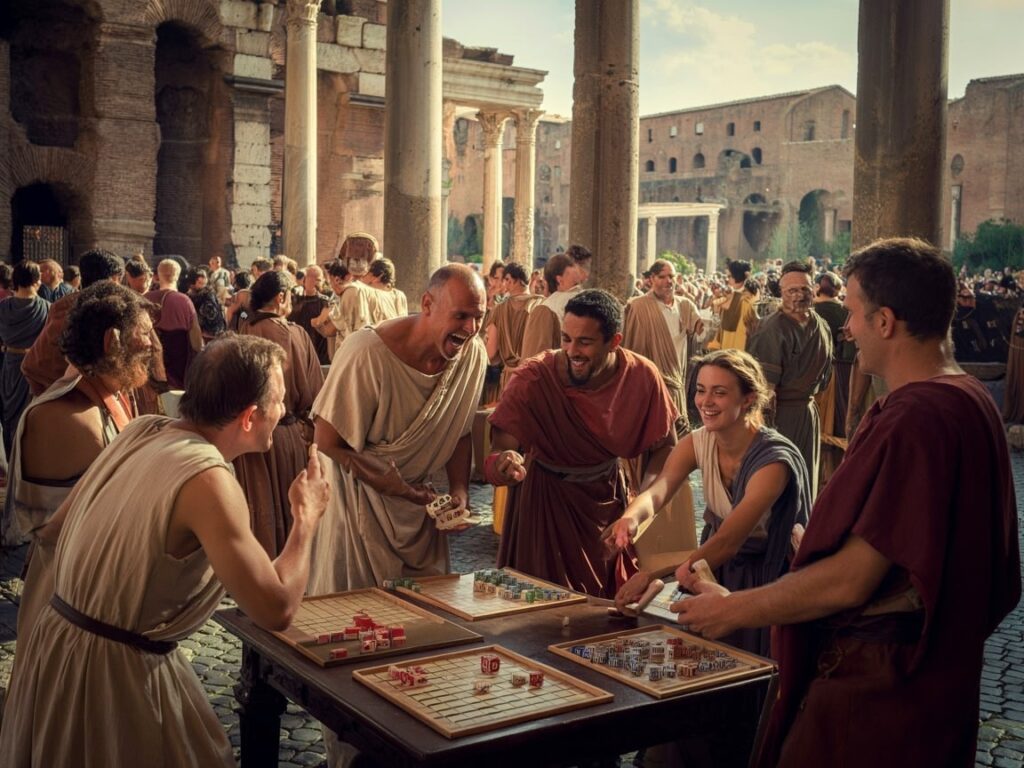
The Enduring Legacy of Ancient Roman Board Games
Roman board games left a lasting mark far beyond the empire’s borders and lifespan. Their concepts traveled extensively along Roman trade routes, facilitating cultural exchange with neighboring civilizations. This dissemination introduced Roman gaming ideas to diverse cultures, where adaptations and local variations took root.
Some key points highlight this enduring legacy:
Persistence into medieval Europe: Variants of Roman games like Duodecim Scripta evolved into popular medieval pastimes, including early forms of backgammon. These games retained core mechanics but incorporated regional rules and styles, bridging ancient and medieval leisure traditions.
Linguistic influence: Numerous European languages absorbed gaming-related vocabulary derived from Latin terms associated with these board games. Words connected to dice, moves, and gameplay trace their origins to Roman terminology, underscoring the deep cultural penetration of Roman recreational practices.
Cultural impact beyond Rome’s fall: The social and strategic dimensions of these games shaped communal interactions for centuries. By fostering mental challenge and social bonding, Ancient Roman board games helped establish leisure patterns that persisted throughout European history.
The fascination with strategy, chance, and competition embodied by these games reveals a side of Roman life rich in intellectual play and social connection—entertainment beyond gladiators and chariots, continuing to resonate through time.

